Looking Back on the Pandemic Kirtan That Reached 1.2 Million and Inspired a Flood of Virtual Kirtan Events
By Madhava Smullen | Aug 11, 2020
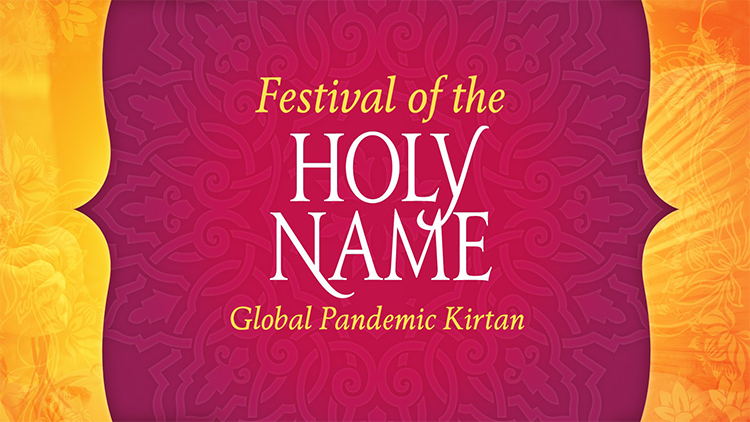
Since the beginning of the COVID-19 pandemic, ISKCON devotees have adjusted to staying at home by organizing a whole host of creative online events in place of in-person festivals and seminars. One of the most popular virtual events, drawing at least 1.2 million viewers, engaging multiple generations of devotees and inspiring many others to hold their own major online kirtan events to this day, was the Global Pandemic Kirtan, organized by team members of Alachua, Florida’s Festival of the Holy Name from April 18th to May 3rd 2020.
Here we look back on the event, its success, the other events it inspired, what it means to all the generations who participated, and its impact in a world where virtual outreach may be the norm in ISKCON for some time to come.
“We Had No Idea How It Would Catch On”
The annual Festival of the Holy Name, launched in 2010, was created by second generation devotees who wanted to provide an immersive experience for Alachua community members who couldn’t make it to kirtan events around the country. When the pandemic hit and people had to stay at home, a subgroup from the team behind the festival — Gaura Shakti and Krishna Dhama Allin, Saradiya and Govinda Syer, Govinda Cordua and Nila Khurana – decided to create a virtual version, with chanters streaming live Maha Mantra Kirtan from their homes around the world.
“Our intention is to have the Holy Name reverberate continuously throughout the world to bring relief for the current global pandemic and all other ailments of Kali Yuga,” the group wrote at the time. “We are performing this sacrifice for the well-being of all.”
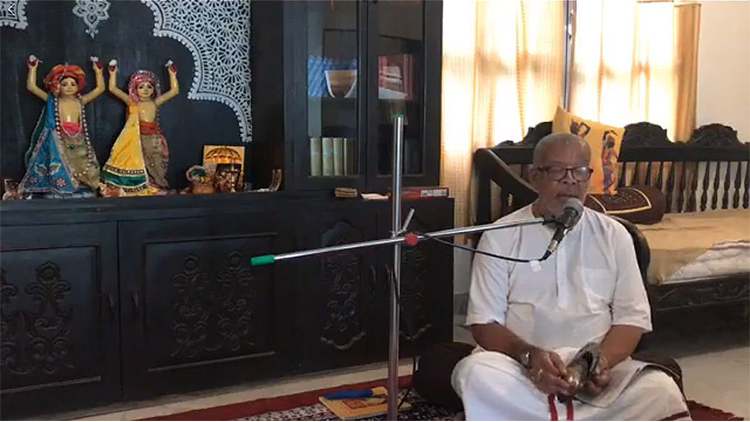
Agnideva Das chants
At first, the team planned to hold a 24-hour kirtan event, as is common. “We had no idea how it would catch on,” says Nila Khurana, who helped with systems and administration. “We hadn’t advertised at all, just a little word of mouth, and only gave people two days’ notice.”
But the event snowballed quickly, gathering a huge queue of people waiting to chant live on its Facebook page. After a three-hour gap the first night, the kirtan went on non-stop for 108 hours, and was then extended by the same duration twice due to popular demand.
A Global Phenomenon
In total, from April 18th to May 3rd more than 400 singers along with participants in over 150 countries joined together online for 360 hours, or 15 days of nonstop live Maha-Mantra Kirtan. Chanters hailed from Australia, Belgium, Canada, Hawaii, Germany, Indonesia, South Africa, Kenya, Iceland, Guyana, Slovenia, Mauritius, Switzerland, the Netherlands, the US, the UK and many, many more countries.
Over 1,400 posts were made on the Global Pandemic Kirtan Facebook page, mostly kirtan videos. There were 1.2 million reactions to these videos from around the world, and 51,000 comments.
Among the chanters were Radhanath Swami, Sacinandana Swami, Giriraja Swami, B.B. Govinda Swami, Bhaktimarga Swami, Agnideva Das, Jahnavi Harrison, Visvambhar Sheth, Amala Harinama and Nadiya Mani, Gaura Vani, Ananda Monet, Madi Das, Bali and Dhanya, Sri Prahlad and many, many more.
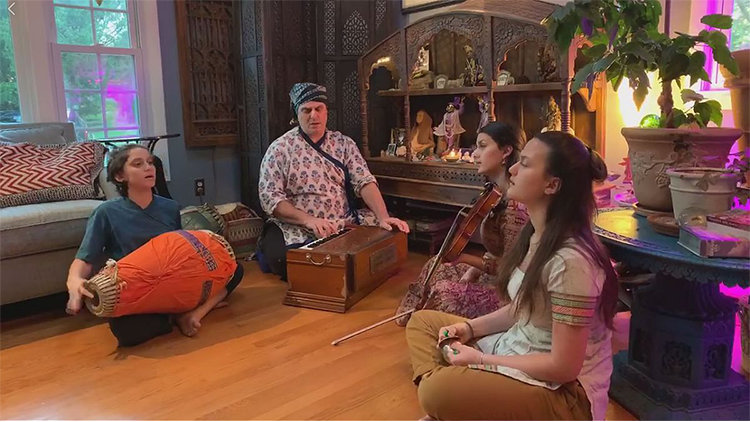
Gaura Vani and family
Bringing People Together During A Time of Isolation
Along with these well-known chanters who had been used to chanting in front of thousands of people before the pandemic, there were also many whose names were not so familiar, and who had only chanted in their homes in front of their Deities.
“In this festival you could see people that were super skilled and professional musicians, and then you could see those who had never sung on stage before in their life,” Nila says. “And they were all trying to chant as purely as they could for the pleasure of the Lord and His devotees.”
The Global Pandemic Kirtan also brought people from different spiritual groups together under one goal – chanting the Holy Name.
“Even though there were people from all different lines, who had different philosophies, we were all chanting Krishna’s name together, and it was nice to see that unity,” Nila says.
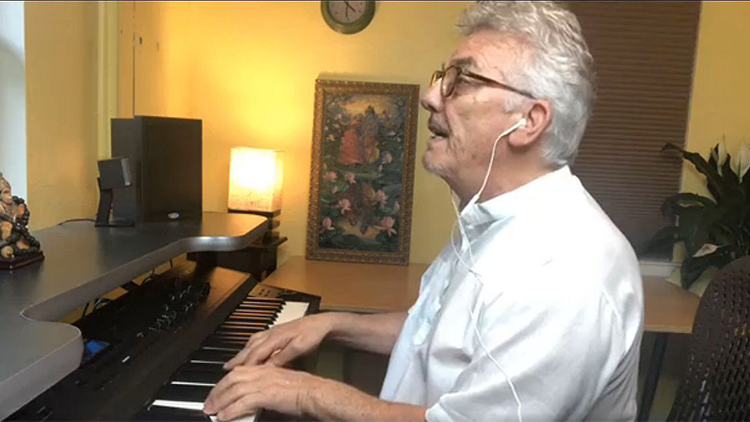
Havi Das chants
In addition, the Pandemic Kirtan reconnected old friends who hadn’t seen each other in decades. Nila recalls: “People wrote to me saying things like, ‘I was around when Srila Prabhupada was on the planet, and I got burnt out and left the movement. Now I’m seeing all my old friends chanting, and they’re watching me, and I just feel so inspired to be able to share my kirtan with all these devotees I haven’t seen in thirty plus years.’”
“That was definitely one of the highlights of the festival for me,” Nila says. “To see that kind of connection happen in a time when we’re all so isolated.”
Families and the Younger Generation Inspire Multitudes
Some of the most popular kirtans in the festival were led not only by renowned senior devotees, but also by families and the younger generation, providing hope for the future of ISKCON.
One kirtan from the UK, by second generation devotee Kishori Jani, her husband Birju Jani and their four children, became a viral phenomenon, with 16 million views as of now, and thousands of comments and shares.
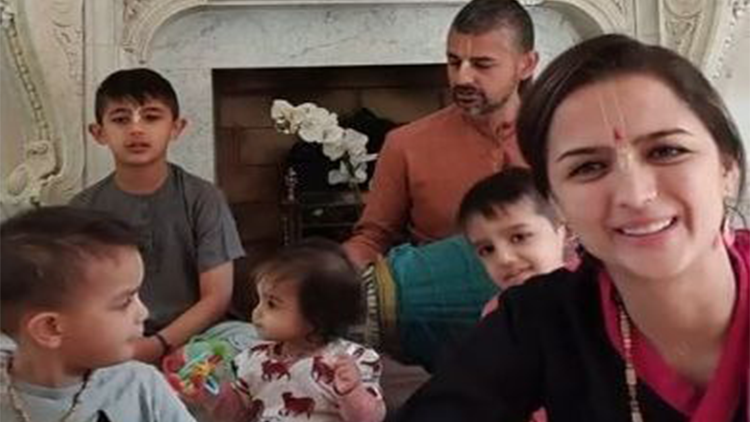
Kishori Jani, Birju Jani and their four children became a viral sensation
Yadubara Das, Govinda and Saradiya Syer, Visvambhar and Vrinda Sheth, and many others also led sweet kirtans together with their families.
Meanwhile many young adolescents were inspired to participate, and were often the driving force encouraging their family members to chant. Gita, Govinda and Saradiya’s daughter; Sundari, Abhay and Ashley Khurana’s daughter; and Mayuri from New Jersey were among the youth, aged 11 to 14, who organized and led incredible kirtans with their families.
“I think kirtan in general is one way that a lot of the youth connect and are able to participate and feel inspired,” Nila says.
Not all families were by blood – several close-knit outreach groups that live together and have quarantined together since the beginning of the pandemic, such as Rama Raya Dasa’s Harinama Ashram, also performed much appreciated “family” kirtans.
This family mood was one of the most inspirational elements of the festival to organizers like Nila, even crossing geographical distance.
“When I saw devotees in Kenya, or Iceland – places where there are very few devotees compared to Alachua – I was really inspired that they were still sitting there and chanting so enthusiastically every day,” says Nila. “And I felt connected to them, like we had a common interest. I wanted to support them, to encourage them. They felt like part of my family.”

Madhava chants
The Ongoing Impact of the Global Pandemic Kirtan
The response to the online kirtan festival was nothing short of rapturous, encouraging the organizers to keep going far beyond their original plan, and to serve for ten-hour days.
“People were looking forward to every single kirtan and staying up till 2:00am watching each one,” Nila says. “Many said it was one of the only solaces they had during this time, when there’s so much fear, anxiety and stress.”
While the Global Pandemic Kirtan eventually concluded after 360 hours, organizers created a manual for others, and the phenomenon has gone on to inspire or guide other similar online events around the world.
These included the Toronto 12-Day Virtual Rathayatra Festival, Kirtan Fest Global, Kirtan Fest India, and Kirtan Sanga (Mauritius), who went on for even longer than their inspiration, broadcasting 12 hours of kirtan a day for one month straight and continuing with more to this day.
Due to the simplicity of the technology – filming using one’s phone and posting it to Facebook Live – many more are sure to continue.
The Future of Festival of the Holy Name
In the future, even if pandemic restrictions eventually lift to the point that some kind of live annual Festival of the Holy Name event is possible, the team would continue to supplement it with a virtual component by either streaming the in-person event internationally on the platform they’ve created, or holding a separate virtual kirtan event at a different time of the year.
“Then we could connect in kirtan with those devotees who are more isolated, and don’t necessarily leave their remote corners of the world,” says Nila. “So we definitely see it as something we would want to continue even beyond the immediate crisis of the pandemic.”












